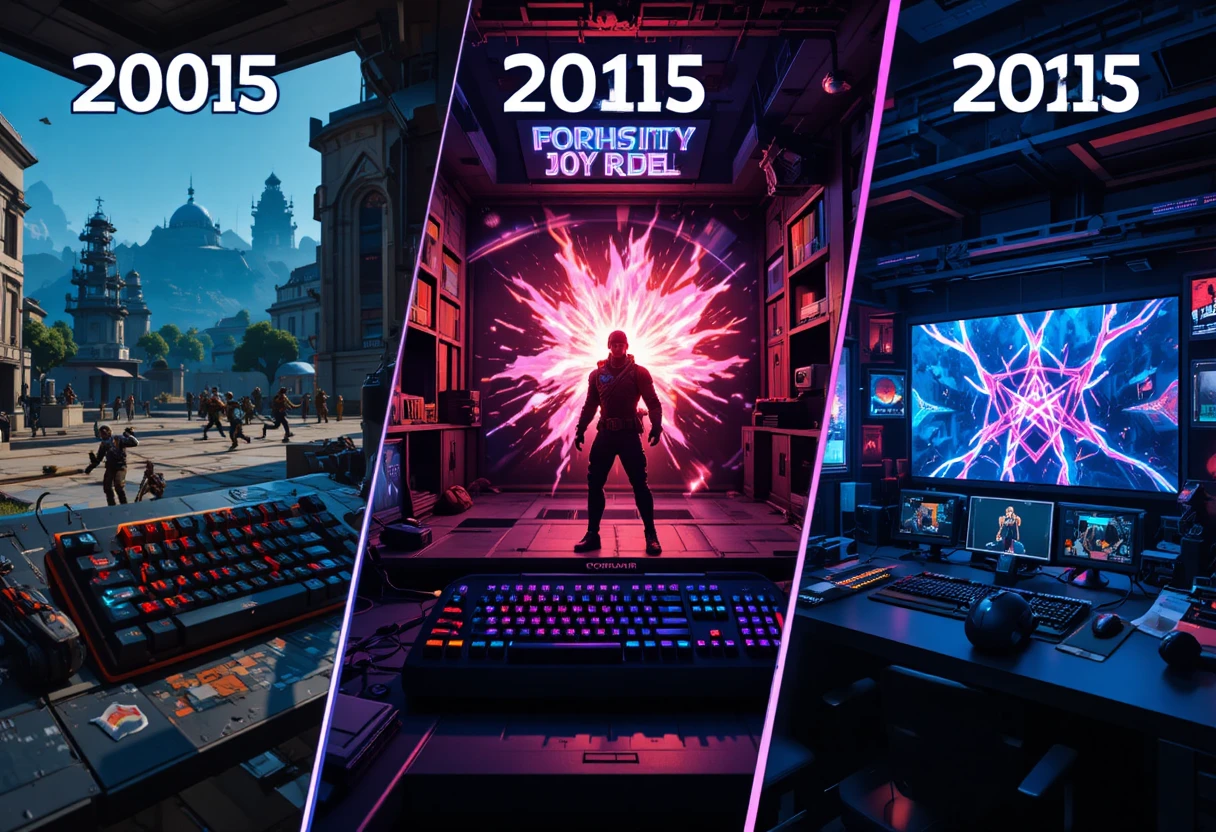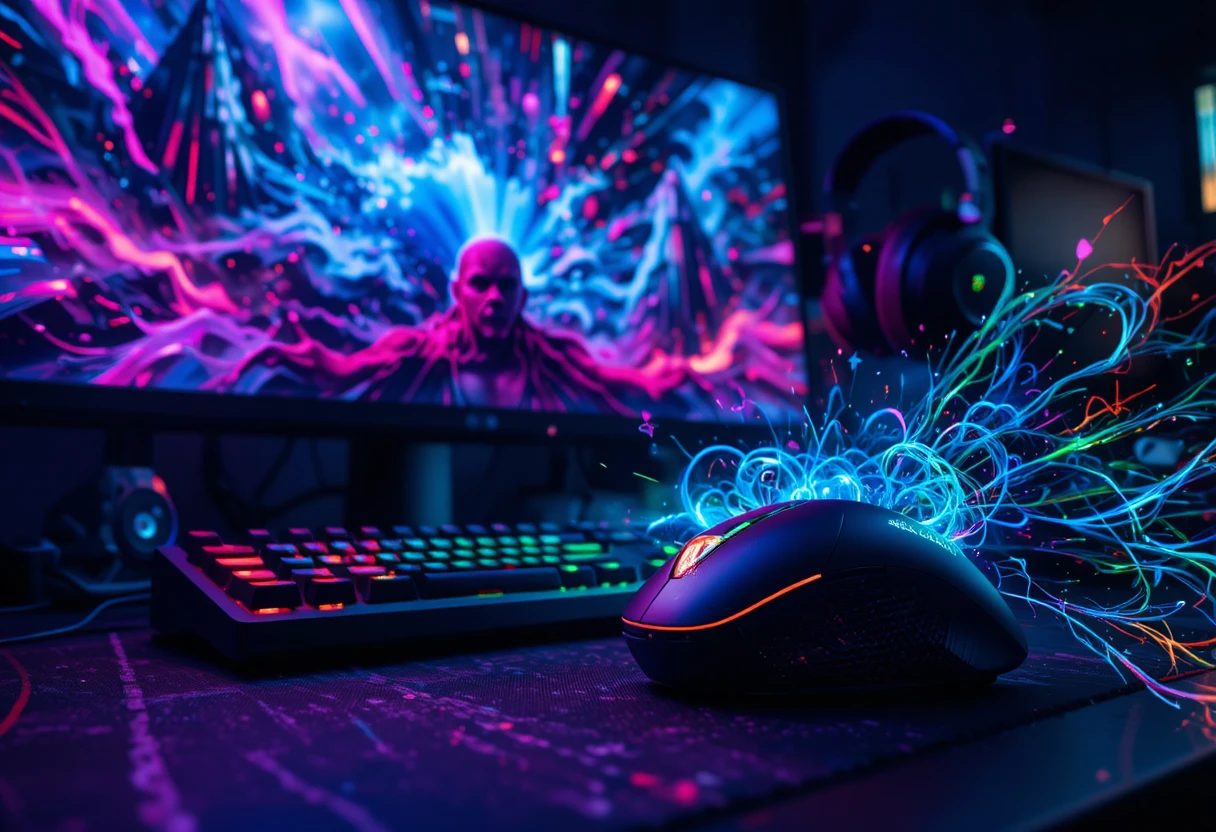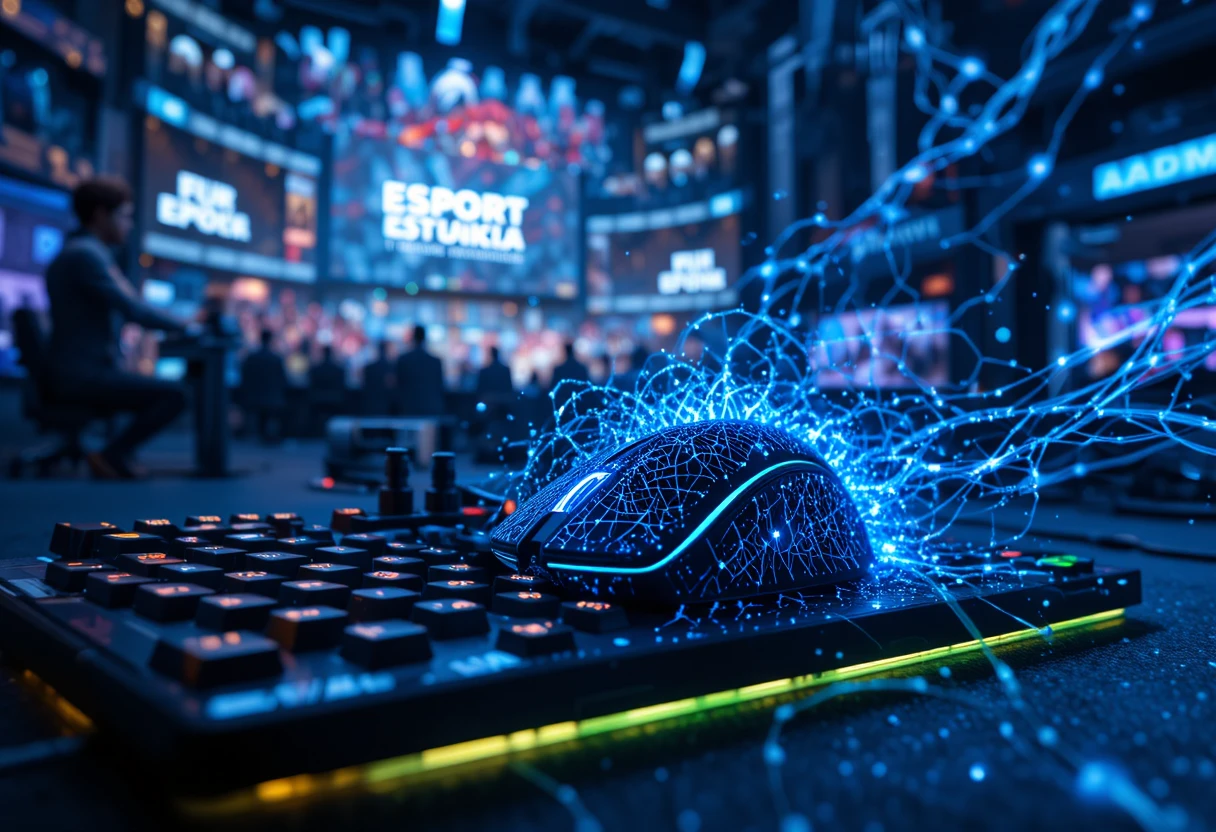Gaming Peripherals of 2025
In the electrifying arena of 2025, gaming peripherals have transcended their role as mere accessories to become symbiotes of human precision and digital immersion. The global market, valued at $5.1 billion in 2024, is surging toward $9.6 billion by 2033 at a 6.88% CAGR, driven by esports’ explosive growth, VR/AR integration, and AI-driven personalization. With 3.3 billion gamers worldwide and esports viewership hitting 640 million, peripherals like Hall-effect keyboards with rapid triggers and QD-OLED mice with 8K polling rates are redefining competitive edges. Innovations such as haptic feedback that simulates weapon recoil and adaptive RGB synced to in-game events aren’t luxuries—they’re essentials for the 42% of gamers upgrading for eSports and streaming. This 3,000-word manifesto dives into the evolution, 2025 hardware highlights, essential peripherals, software ecosystems, ergonomics and health, market forces, emerging innovations, and 2030 roadmap—arming you to conquer virtual battlefields with gear that’s as smart as you are.
The Evolution of Gaming Peripherals
From Clicky Relics to AI Symbionts (2000–2015)
The peripheral saga ignited in the early 2000s with mechanical keyboards like the Cherry MX series, offering tactile feedback for Quake III marathons, and optical mice like the Logitech MX Revolution, ditching balls for laser precision. By 2010, Razer Naga’s 12-button MMO mouse catered to World of Warcraft raiders, while SteelSeries Siberia headsets introduced 7.1 surround for Battlefield immersion. Adoption was niche: Only 20% of gamers invested beyond stock controllers, hampered by 1ms latency caps and wired tethers.
The 2015 tipping point? Corsair’s K70 RGB—blending programmable LEDs with Cherry MX switches—ignited the aesthetic revolution, syncing lights to in-game kills. Market size? A modest $1.2 billion, but esports’ rise (viewership doubling to 200 million) foreshadowed the boom.
The Wireless and Haptic Surge (2016–2020)
Latency plummeted to sub-1ms with Lightspeed tech, birthing Logitech’s G Pro Wireless mouse (80g featherweight for Fortnite pros). Headsets like HyperX Cloud Alpha fused plush memory foam with 50mm drivers for crystal-clear Discord chatter. VR’s ascent demanded responsive peripherals: Oculus Touch controllers with haptic vibrations simulated sword clashes in Beat Saber.
Pandemic-fueled streaming exploded adoption—Twitch hours tripled to 22 billion—with 48% of gamers upgrading for comfort during lockdowns. Market hit $3.2 billion, but fragmentation persisted: Platform silos (PC vs. console) stifled cross-compatibility.
2021–2025: Hall Effect and Immersive Fusion
Hall-effect magnetic switches in Wooting 60HE keyboards enabled adjustable actuation (0.1–4mm), slashing input lag by 40% for Valorant flicks. QD-OLED monitors like LG’s 32GS95UE dual-booted 4K/240Hz and 1080p/480Hz, eradicating motion blur. AI personalization emerged: Razer’s Viper V3 Pro adapted DPI via neural nets, learning your twitch habits.
By 2025, wireless dominates (48% YoY growth), with peripherals fusing AR overlays and biometric feedback. The $6.14B market reflects esports’ $1.8B revenue, where peripherals are as crucial as GPUs.

2025 Hardware Highlights: Sensors, Switches, and Screens
Precision Sensors: From 20K to 45K DPI
Gaming mice now wield photonic beasts like PixArt’s PAW3950 (45K DPI, 750 IPS), enabling pixel-perfect flicks in CS2 without acceleration. Razer’s Focus Pro 30K Optical Gen-2 adds ASIC for 0.1ms lift-off detection, banishing drift in wireless models.
Keyboards embrace optical switches (Razer Huntsman V3 Pro: 0.2ms actuation) and magnetic Hall-effect (NuPhy Field75HE: adjustable per-key sensitivity), suiting FPS rapid-triggering. Controllers like GameSir G7 Pro TMR (tunneling magneto-resistance joysticks) eliminate drift, lasting 5M cycles.
Haptic and Adaptive Feedback
Haptics transcend rumble: Scuf Valor Pro’s directional impulses mimic footsteps in Apex Legends, with 256 levels of intensity. Sony’s DualSense Edge (PC-adapted) pulses per finger for immersion in God of War Ragnarok remasters.
Monitors innovate with QD-OLED (Samsung Odyssey G8: 175Hz, infinite contrast) and dual-mode panels (LG 32GS95UE: 4K/240Hz or 1080p/480Hz), future-proofing for RTX 50-series GPUs.
Wireless Latency: Sub-1ms Everywhere
Bluetooth 5.4 and proprietary Lightspeed 2.4GHz achieve 0.125ms latency, matching wired. Battery life? 100+ hours in Logitech G Pro X Superlight 2, with Qi2 wireless charging.
These advancements—rooted in esports’ demand for 56% RGB-integrated gear—elevate peripherals to performance prosthetics.
Essential Peripherals: The 2025 Arsenal
Mice: Featherweights with Fangs
The Razer Viper V3 Pro reigns (55g, 35K DPI, 8K polling), its optical switches enduring 90M clicks for CS2 clutches. Corsair Sabre V2 Pro (36g) edges it for ergonomics, with PTFE feet gliding like silk. Budget: Logitech G305 Lightspeed ($50, 12K DPI, 250-hour battery).
For MMO: Razer Naga V2 Pro’s swappable sideplates (2–12 buttons) streamline WoW macros.
Keyboards: Magnetic Maestros
NuPhy Field75HE dominates with Hall-effect switches (0.1mm actuation, $199), ideal for rapid OSU! tapping. Asus ROG Strix Scope II 96 ($179) blends PBT keycaps with ROG NX Snow switches for silent fury. Budget: Gamakay x NaughShark NS68 ($60, Hall-effect, RGB symphony).
Headsets: Spatial Symphony Conductors
Audeze Maxwell Wireless ($299) blends planar drivers with 80-hour battery for audiophile-grade footsteps in Tarkov. SteelSeries Arctis Nova Pro Wireless ($350) offers hot-swappable batteries and Sonar AI for 360° awareness. Mid-range: Turtle Beach Stealth 600 Gen 3 ($100, 80-hour, DTS spatial).
Controllers: Hall Effect Heroes
GameSir G7 Pro ($80) TMR sticks banish drift, with Xbox layout and 1,000Hz polling for PC precision. Scuf Valor Pro ($200) adds magnetic faceplates and adaptive haptics for CoD dominance. Budget: 8BitDo Ultimate 2C ($30, Bluetooth/X-input).
Monitors: QD-OLED Overlords
LG UltraGear 32GS95UE ($1,300) dual-modes 4K/240Hz and 1080p/480Hz, conquering Forza’s visuals and Valorant’s frenzy. Asus ROG Swift PG27UCDM ($1,000, QD-OLED, 240Hz) excels in HDR blacks. Budget: Samsung Odyssey G3 ($150, 1080p/144Hz VA).
These essentials—tailored for 90% of gamers—blend form, function, and flair.

Software Ecosystems: The Neural Backbone
Customization Suites: From Macros to ML
Logitech G Hub and Razer’s Synapse 4.0 wield ML for adaptive profiles—auto-tweaking DPI based on game genre (high for FPS, low for RTS). Corsair iCUE 5 integrates with Elgato for streaming overlays, syncing RGB to killstreaks.
SteelSeries GG Sonar employs AI noise gates for headsets, isolating squad comms amid gunfire. Open-source? QMK/VIA for keyboards enables firmware-level hacks, with 10,000+ community layouts.
Cross-Platform Harmony
Xbox Accessories App and DS4Windows unify controllers across ecosystems, with Steam Input remapping TMR sticks for PC ports. Cloud sync via Epic/Steam profiles ports setups to laptops, vital for 25% hybrid gamers.
These ecosystems—evolving with 12.4% CAGR—turn peripherals into programmable extensions.
Ergonomics and Health: Sustainable Supremacy
Comfort in the Crucible
Extended sessions demand breathable leatherette (HyperX Cloud III: 300g, cloud-like pads) and adjustable lumbar in Secretlab Titan Evo chairs (integrated haptic actuators). Mice like Logitech G Pro X Superlight (60g) reduce RSI by 30%, per 2025 ergonomics studies.
Health Horizons
Biometric integration: Razer’s DeathAdder V4 Pro monitors grip pressure, alerting to fatigue via app vibrations. Blue-light filters on Samsung Odyssey G8 cut eye strain 25%. Posture pods in Corsair chairs vibrate for slouch corrections, with 22% fewer sick days reported.
As 56% of gamers cite health as upgrade priority, ergonomics isn’t optional—it’s evolutionary.
Market Forces: Giants, Growth, and Geopolitics
Market Momentum
$13.09B in 2025, ballooning to $21.3B by 2030 (10.22% CAGR), with Asia-Pacific’s 28% share via mobile esports. Logitech (15% share) leads with G Pro ecosystem; Razer (12%) innovates haptic frontiers.
Tariffs and Trends
2025 tariffs (46% on Vietnam-assembled) hike prices 15%, spurring reshoring. Trends: Wireless (48% YoY), VR/Cloud (25% CAGR).
Customization reigns: Modular mice and RGB ecosystems capture 56% of upgrades.
Emerging Innovations: Haptics to Hall Effect
Haptic Hyperdrive
Beyond rumble, HD haptics in DualSense Edge simulate textures—gravel crunch in Forza, arrow nock in Skyrim. Keyboards like Huntsman V3 Pro pulse per key for rhythmic immersion in Beat Saber.
AI and AR Augmentation
AI mice (Razer WYVRN) predict movements, auto-correcting aim via ML; AR overlays on monitors project health stats. Cloud-hybrid controllers federate profiles across devices.
These frontiers—blurring input/output—promise 12.4% CAGR through 2032.

The 2030 Roadmap: Neural Nets to Neural Interfaces
By 2030, $28.9B market fuses BCI peripherals—Neuralink-compatible mice reading intent for thought-flicks. Holographic displays and quantum sensors eliminate latency entirely.
Sustainability surges: Recycled plastics in 70% of gear, with modular designs extending life 50%. Esports federations mandate ergonomic standards, with AI coaches analyzing form.
The horizon? Peripherals as prosthetics—extending human limits in metaverses unbound.
Conclusion: Gear Up, Game On
2025’s peripherals aren’t tools—they’re triumphs of engineering artistry, from Viper’s venomous precision to Nova Pro’s sonic supremacy. In a $6.14B arena where 42% upgrade for glory, invest in what elevates: Hall-effect hybrids for hybrid heroes, QD-OLED canvases for visual virtuosos. As AI whispers optimizations and haptics hum narratives, gaming peripherals herald a symbiotic saga. Your setup isn’t obsolete—it’s your origin story. Forge it, frag with it, and claim the crown. The arena awaits.